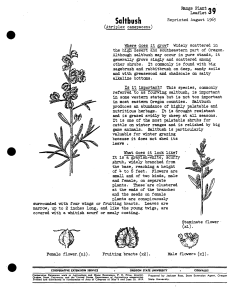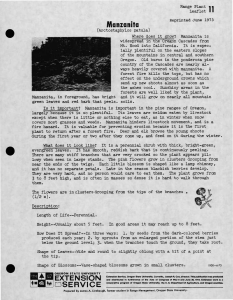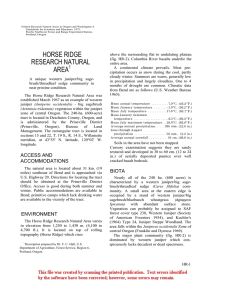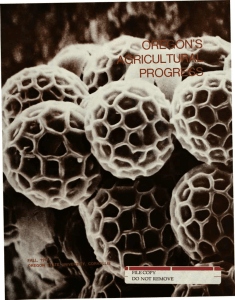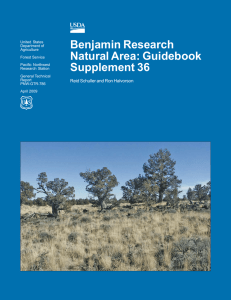Bitterbrush
advertisement
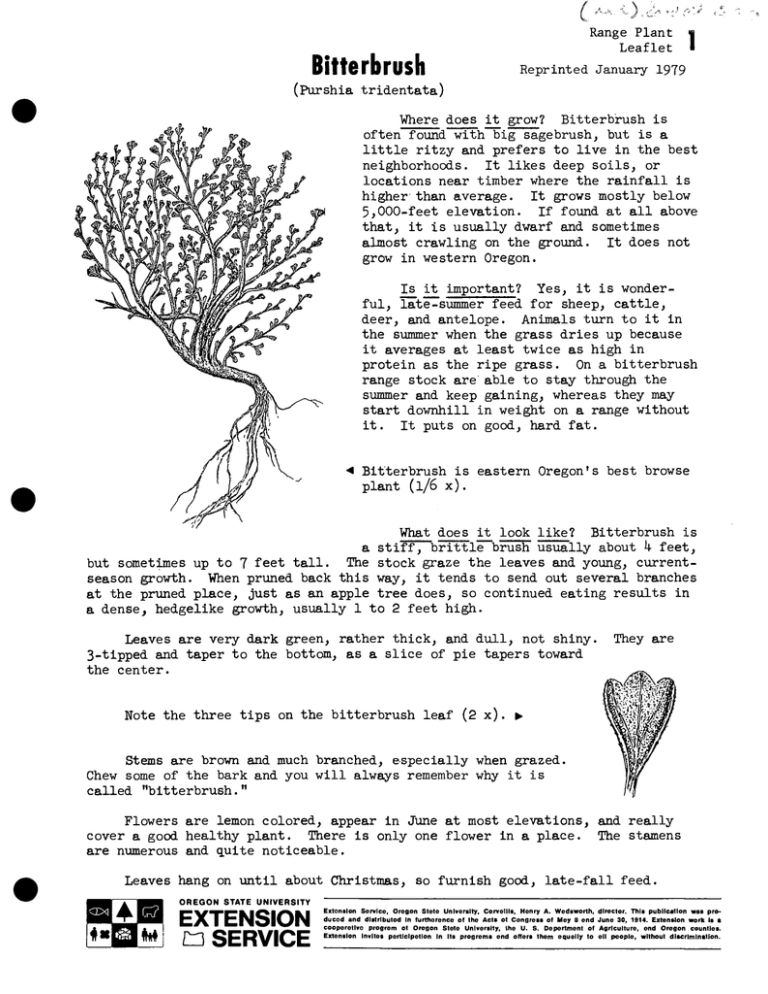
Range Plant Leaflet Bitterbrush < Reprinted January 1979 (Purshia tridentata) Where does it grow? Bitterbrush is often found with big sagebrush, but is a little ritzy and prefers to live in the best neighborhoods. It likes deep soils, or locations near timber where the rainfall is higher than average. It grows mostly below 5,000-feet elevation. If found at all above that, it is usually dwarf and sometimes almost crawling on the ground. It does not grow in western Oregon. Is it important? Yes, it is wonderful, late-summer feed for sheep, cattle, deer, and antelope. Animals turn to it in the summer when the grass dries up because it averages at least twice as high in protein as the ripe grass. On a bitterbrush range stock are able to stay through the summer and keep gaining, whereas they may start downhill in weight on a range without it. It puts on good, hard fat. < Bitterbrush is eastern Oregon's best browse plant (l/6 x). What does it look like? Bitterbrush is a stiff, brittle-brush usually about k feet, but sometimes up to 7 feet tall. The stock graze the leaves and young, currentseason growth. When pruned back this way, it tends to send out several branches at the pruned place, just as an apple tree does, so continued eating results in a dense, hedgelike growth, usually 1 to 2 feet high. Leaves are very dark green, rather thick, and dull, not shiny. 3-tipped and taper to the bottom, as a slice of pie tapers toward the center. They are Note the three tips on the bitterbrush leaf (2 x) Stems are brown and much branched, especially when grazed. Chew some of the bark and you will always remember why it is called "bitterbrush." Flowers are lemon colored, appear in June at most elevations, and really cover a good healthy plant. There is only one flower in a place. The stamens are numerous and quite noticeable. Leaves hang on until about Christmas, so furnish good, late-fall feed. OREGON STATE UNIVERSITY EXTENSION a SERVICE Extension Service, Oregon State University, Corvallls, Henry A. Wadsworth, duced and dlstrtbutod In furtherance ot the Acts of Congress of May 8 and cooperative program of Oregon State University, the U. S. Department ot Extension invites participation In Its programs and offers them equally to director. This publication was proJune 30, 1914. Extension work is a Agriculture, and Oregon counties. all people, without discrimination. Description; Length of Life—Many years. Cut an old plant and count the rings. Height—Usually 3 to h feet, may grow to 7, or if grazed heavily may be only 1 foot. Growth Period--Leaves come out about middle of April, flowers come in June, leaves drop off in middle of winter. How Does it Spread?—Entirely by seeds that are slow to sprout. Shape of Leaves--Broad and 3 fingered at tip, tapering downward, like a wedge. Location of Leaves—Scattered along all of the small stems. Shape and Size of Seed—About half an inch long. Imagine a bowling pin with the knob broken off. Other Names—Antelope brush, deer brush buckbrush, quinine brush, chaparral. Bark—Dull brown. How to Use it—Reserve bitterbrush pastures for late summer and fall; moderate use is good for it, makes it branch out and increase in size. Heavy use, taking all the new growth and nearly all the leaves, will kill it. Is there anything else that looks like TE? No, no other plant resembles it except at a distance. Snowberries, service berries, manzanita, and other low brush found with it do not have the wedge-shaped leaves with the three tips. Sagebrush is grayish green, not dark like bitterbrush. Here is the home of bitterbrush— ► rocky hillsides up near the timber where rainfall is better. ' *■' ':"*S: :^m






